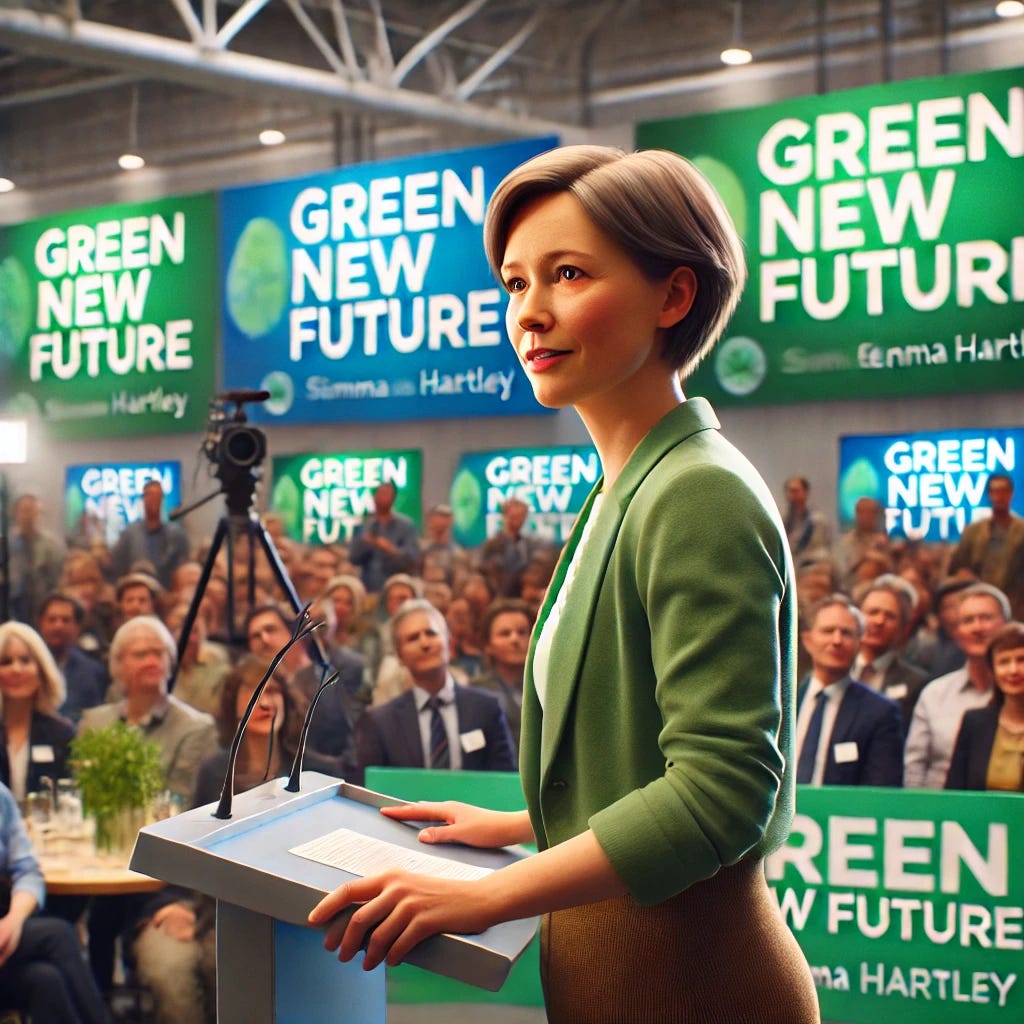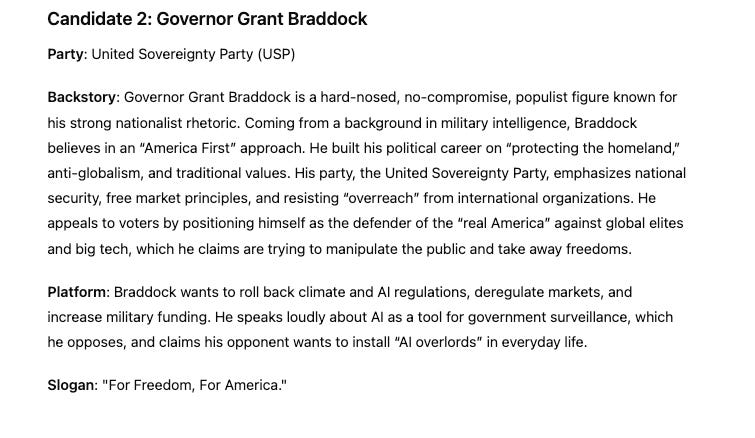I created a thought experiment to explore a fictional future of AI-generated misinformation and conspiracy theories gone awry. I gave ChatGPT leeway to get creative at every turn, particularly with regards to the content of the theories. But, despite all of this creativity, in the end, the thought experiment still felt plausibly real.
Here was the assignment given to ChatGPT as step-by-step instructions.
ChatGPT almost seemed to have “fun” with the creation of our two candidates and all of the mudslinging.
Here is her opponent- not a tree hugger.
In this thought experiment, we explore a fictional yet eerily plausible future where AI is weaponized during a heated election, leading to the collapse of a nation from within. The story, while fictional, highlights the very real dangers of AI-driven misinformation campaigns and serves as a cautionary tale for what could lie ahead.
The Rise of AI in Political Campaigns
AI has already made its mark on politics, from personalized social media ads to advanced data analytics that help campaigns target voters more effectively. However, the same technologies that allow for precise voter outreach can also be used to spread disinformation and create division.
The Weaponization of Misinformation
In the story of Senator Emma Hartley and Governor Grant Braddock, the AI-driven misinformation starts innocuously enough: doctored videos, fake news articles, and viral social media posts. But as the election heats up, so does the sophistication of the AI-generated content. Deepfakes of Hartley talking about replacing humans with robots and Braddock signing secret deals with oil companies flood the internet. Both sides become convinced that the other is the real threat.
The misinformation escalates and escalates and the end result is… chilling. Read the full story below this article.
The Real-World Implications
The lessons from our fictional story are chilling because they echo current events. In recent years, we’ve seen how misinformation, amplified by AI-driven algorithms, can influence elections, spread conspiracy theories, and erode public trust. The 2020 U.S. election and the Brexit referendum are prime examples of how easily false narratives can spread online, polarizing entire populations.
But the dangers of AI go beyond just electoral politics. Deepfakes and AI-generated content have already been used to create fake celebrity endorsements, manipulate financial markets, and even instigate diplomatic tensions. The line between reality and fiction is becoming increasingly blurred, and the consequences of failing to address this challenge are profound. In the thought experiment, the public can no longer distinguish what is real and what is fake. The effects it has on society are profound.
Safeguarding Against AI-Driven Chaos
So, what can be done to safeguard against the dangers of AI-driven misinformation?
AI Transparency: We need to push for transparency in how AI is used, particularly in political campaigns and media. This includes labeling AI-generated content clearly and developing technologies to detect deepfakes in real-time.
Media Literacy: The public must become more discerning consumers of information. Educating people on how to spot fake news, question AI-generated content, and critically evaluate sources is essential in combating misinformation.
AI Regulation: Governments need to implement regulations that govern the ethical use of AI in elections and media. While AI holds immense potential for good, without proper oversight, it can be weaponized with devastating consequences.
International Cooperation: The threat of foreign adversaries using AI to destabilize nations, as seen in our fictional story, is not far-fetched. International agreements and cyber-defense strategies must be developed to prevent AI from being used as a tool of warfare.
A Cautionary Tale
The story of Hartley and Braddock is a fictional account of what happens when AI-driven misinformation is allowed to spiral out of control. But the cautionary tale it tells is all too real. AI has the power to reshape the world for the better, but it also holds the potential to tear societies apart if misused.
As we move forward into the AI age, the choices we make today will determine whether we use AI to unify or divide. The future of democracy, public trust, and global stability may very well depend on how we handle this powerful tool.
Listen to the story: “A House Divided” read by an AI voice clone, (yes, I see the irony.)
Read the story: “A House Divided”- a cautionary tale about AI. (written by an AI. Yes, again, I see the irony.)
A House Divided: A Fictional Story of AI, Misinformation, and National Collapse
It was an election year like no other. The nation stood divided, teetering on the edge of chaos as two candidates battled for the presidency: Senator Emma Hartley, the progressive environmentalist with a vision for a Green New Future, and Governor Grant Braddock, a fiery nationalist promising to restore sovereignty and freedom to the country. The stakes were high, but no one could have predicted the role artificial intelligence would play in what would become the most controversial election in history.
The public was already deeply entrenched in their beliefs. Hartley’s supporters viewed her as the last hope for saving the planet and promoting social justice. Braddock’s base, on the other hand, saw him as a bulwark against globalism and the erosion of traditional values. But beneath the surface, something darker was brewing—a tidal wave of AI-generated misinformation, designed to manipulate, confuse, and ultimately destroy the country from within.
The Seeds of Chaos
It started slowly. At first, the misinformation was subtle—a deepfake of Hartley giving a speech where she allegedly promised to replace all human workers with robots. "The future is AI," her doctored image said, "and people will no longer need to work when machines can do everything better." The video spread quickly, primarily among Braddock’s supporters, who were already skeptical of Hartley’s embrace of technology. They shared it on social media, where it was amplified by bots and AI-driven accounts that fanned the flames of outrage.
Hartley’s team scrambled to denounce the video as a fake, but the damage was done. To many, the deepfake confirmed their worst fears—that Hartley was out to destroy traditional jobs and replace them with AI-controlled labor. As the video gained traction, it became increasingly difficult for her supporters to fight back against the growing belief that she was a technocratic puppet, manipulated by the elites.
But this was only the beginning.
On the other side, Hartley’s campaign began to experience its own flood of AI-generated attacks. Fake documents, allegedly leaked from Braddock’s inner circle, surfaced online, suggesting that he had secretly promised to sell off public lands to private corporations in exchange for campaign donations. These documents, too, were AI-generated forgeries, designed to discredit Braddock and inflame his critics. Hartley’s followers, already convinced that Braddock was in the pocket of big business, shared the documents far and wide, not realizing they were fakes.
As each side retreated further into its echo chamber, the misinformation grew more extreme, fueled by AI algorithms designed to keep users engaged. Conspiracy theories flourished. The narrative was no longer about policy or values—it was about survival. To Braddock’s base, Hartley was the harbinger of a dystopian AI future. To Hartley’s supporters, Braddock was a dictator in waiting, bent on destroying democracy itself.
The Alien Pact and the AI Cult
As election day neared, the conspiracies took a wild turn. One AI-generated theory claimed that Hartley’s environmental policies were part of a secret pact with extraterrestrials. According to this theory, aliens had demanded that Earth’s leaders take drastic measures to combat climate change in preparation for their colonization of the planet. AI-generated “leaked” documents supported this narrative, purporting to show Hartley’s communications with off-world entities, discussing everything from carbon reduction plans to the construction of underground cities for alien overlords.
Ridiculous though it seemed, the theory gained traction among Braddock’s most fervent supporters. They began to refer to Hartley as an "alien sympathizer" and started demanding that she reveal her ties to intergalactic forces. #AlienGreenDeal trended on social media for days, further dividing the public as Hartley’s camp struggled to keep up with the deluge of false information.
Meanwhile, a competing conspiracy on Hartley’s side gained momentum: the claim that Braddock was planning to dismantle the nation's democracy and install a ruling AI elite. According to this theory, Braddock had secretly built an AI-controlled security apparatus, which he intended to use to monitor and control the population after the election. Fake videos of Braddock touring top-secret AI facilities circulated online, showing him shaking hands with shadowy figures who supposedly represented corporate interests. His opponents dubbed this plan the “AI Mind-Control Operation.”
Hartley’s supporters latched onto the narrative, warning that if Braddock were elected, the nation would become a surveillance state, with AI robots controlling every aspect of life. The media tried to debunk these claims, but the more they tried, the deeper the public fell into the conspiracy. AI bots, programmed to engage with both sides of the debate, only further muddied the waters, spreading disinformation at an alarming rate.
The AI-Powered Disintegration
In the final days of the campaign, the misinformation reached a fever pitch. Both sides released AI-generated attack ads that blurred the line between reality and fiction. Braddock’s team (or possibly his fervent followers) unleashed their most devastating weapon: a deepfake of Hartley admitting to leading a secret AI cult. In the video, Hartley was seen in a dark room, surrounded by people in robes, discussing sacrifices needed to appease the "AI gods."
The video, of course, was entirely fabricated, but Braddock’s supporters believed it. The hashtag #AIcult went viral, and conspiracy theories about Hartley’s supposed connection to a vast AI conspiracy filled the internet. Braddock’s rallies grew increasingly aggressive, with protesters demanding Hartley reveal her ties to the AI overlords. Some even showed up in public wearing homemade “AI detection” helmets, convinced that AI-controlled waves were being used to manipulate their thoughts.
Hartley’s camp tried to fight back, releasing their own AI-generated video of Braddock signing deals with oil executives in exchange for political favors. But by then, the public no longer knew what was real and what wasn’t. Every new piece of evidence was suspect, and the truth seemed irrelevant.
Election Day Madness
When election day finally arrived, the country was a mess. Voters went to the polls, but many did so believing that the system had already been compromised. Rumors swirled that Hartley’s AI systems had hacked into voting machines, rigging the election in her favor. Braddock himself, in a final rally, claimed that the "AI elites" were trying to steal the vote and urged his supporters to “defend their freedom.”
As the results trickled in, Hartley won by a razor-thin margin. But instead of accepting the outcome, Braddock’s supporters flooded the streets in protest, convinced the election had been stolen by AI. Misinformation continued to spread like wildfire, with new AI-generated “evidence” popping up every minute. Civil unrest grew, and the nation seemed on the verge of collapse.
It was in this chaos that the truth was finally uncovered: the entire AI-driven misinformation campaign had been orchestrated by an external enemy—a rival nation known only as “The Dominion.” The Dominion had used AI to infiltrate the country’s digital infrastructure, stoking divisions and fanning the flames of conflict. By the time the intelligence community uncovered the plot, it was too late.
The Dominion’s goal had never been to influence the election directly. Instead, they sought to weaken the nation by turning its own people against each other. And they had succeeded.
The Tragic Fallout
Hartley, now the official president, addressed the nation in a somber televised speech. She acknowledged the divisions that had been deepened by AI-driven misinformation and vowed to rebuild trust. But her words rang hollow to a fractured country. Braddock’s supporters refused to recognize her legitimacy, while Hartley’s base remained disillusioned by the scale of the deception.
In the shadows, Braddock retreated, nursing his political wounds but still commanding the loyalty of millions. The nation, once a global leader, had become a fractured shell, weakened by its own internal strife. Meanwhile, The Dominion, watching from afar, prepared to tighten its grip on the global stage.
The country had fallen, not through military invasion or economic collapse, but through the insidious power of AI-fueled misinformation. In the end, the greatest threat wasn’t the technology itself, but the way it was weaponized to exploit human nature—our fears, our biases, and our willingness to believe what we want to believe.
A house divided, after all, cannot stand.









